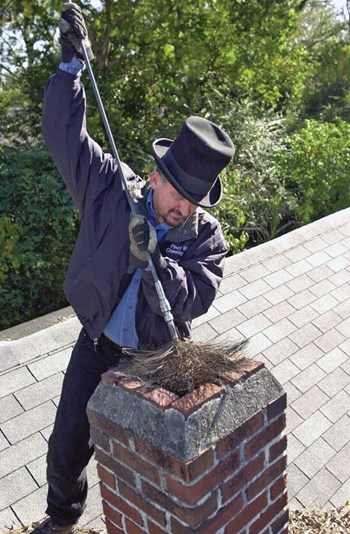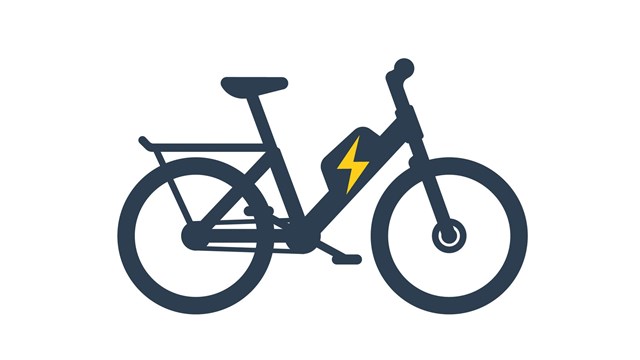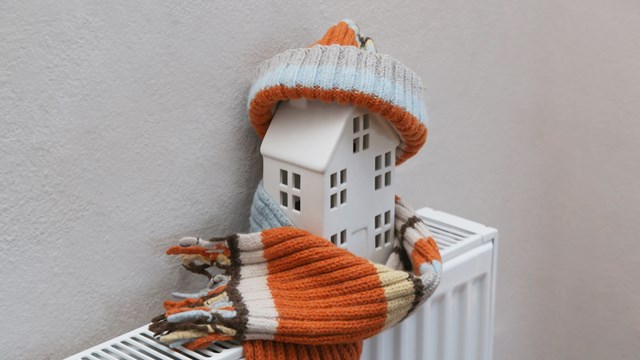
National Public Radio recently ran a story about a piece of advice from the latest edition of The Old Farmer’s Almanac. The suggestion was about how to stay warm throughout the winter with just one log: chuck it out of an upstairs window, run downstairs and outside to pick it up, and then sprint back upstairs and chuck it out the window again. Repeat until warm.
This method may not cut it for the majority of condominium residents because the Almanac, as well many other weather forecasters, is predictingan unusually cold winter for New England. So people may be more inclined to chuck that log into the fireplace and set fire to it than use it for exercise. To that end, we’ve prepared a short list of things to do in preparation for winter so that only the firewood is going up in smoke.
Better Safe Than Smoky
As anybody who has come in from a snowstorm to stand in front of crackling fire knows, burning wood in a fireplace or stove is more than just a way to heat a room. The light and heat, the camaraderie, and for some, the nostalgia are part of what make winter time fires appealing—especially in ski country, where an after-skiing glass of wine in front of a roaring fire is notably popular. But before that wine is uncorked and the first log is torched, there are a few things to consider.
One of the first steps is inspection. Ashley Eldridge of the Chimney Safety Institute of America explains that there are three levels of inspections. Level 1 includes all parts that are readily accessible and visible without much effort. This is the most common type of inspection and is appropriate for most yearly inspections. Level 2 is a step beyond that, requiring visual inspection of many of the inside portions of the fireplace and chimney. This is important in the event of a problem, a change in the fireplace, or the sale of a home. Level 3, which may include cutting open or removal of parts to access the hidden portions is only used in the cases where a problem has been identified.
While Carlton Shippey of Cherry Valley Chimney Sweep in Cherry Valley, Massachusetts, has seen all types of arrangements, he says the most common arrangement for him is one where each condominium owner is required to submit documentation to the condo board that the fireplace unit has been inspected and swept if necessary. This puts the responsibility (and cost) for the inspection on the unit owner and the responsibility for overall supervision on the board. The arrangement allows the condominium owners some flexibility in negotiating their own inspection and chimney sweep services.
Eldridge prefers a different method, where the homeowners association or condo board negotiates a contract for all the units and can ensure access to each unit. That way, the chimney professional has one contact for the entire job and does not have to schedule repeated jobs or chase down separate payments. This can lead to discounts on services and fees.
In either case, some residents who never light a fire complain about paying to service and maintain a fireplace they never use. However, should they ever choose to spark a fire, it is better to be safe than smoky. Of course, it is best to use a certified chimney professional. The Chimney Safety Institute of America certifies chimney sweeps and inspectors. Although anyone can set up business as a chimney sweep, with certified professionals all aspects of the fireplace will be inspected. This is especially important where after-market parts and appliances have been installed on factory-built fireplaces, or where existing fireplaces have been modified to accommodate inserts. In addition, a chimney professional can inspect the venting on all heating appliances like gas-fired dryers, kitchen stoves, and furnaces to ensure safe conditions. The cost of these inspections can run from $80 to $300,depending on the level of the inspection and the accessibility of the unit.
Special Condominium Issues
George Stroup, the president of the New Hampshire Association of Chimney Professionals and Region I director of the Chimney Sweeps Guild, sees a number of important differences between condominiums and free-standing houses. The first is that he sees a much greater number of after-market parts and appliances put on factory-built fireplaces in condominiums. This is a problem, Stroup notes, because rarely are the parts (like a new glass door or fan) manufactured specifically for the unit in which they are installed. This can lead to overheating, melting, and faulty combustion. This is especially common in condos that have switched from wood-burning to gas-fired units. Stroup has been involved in a number of these types of conversions, especially in rental units where owners want to diminish the wear and tear associated with storing and burning wood, and knows firsthand the importance of making sure each part is rated for each particular use and that proper clearances are maintained.
Another challenge for larger condominium complexes is the creation and dissemination of a fire plan: what to do in case of an emergency. For Eldridge, this challenge offers a wonderful opportunity. He suggests that condo boards consider hosting a fire safety day where residents can learn about fire safety and management. In addition, it would be an excellent time for chimney sweeps and firewood providers to hand out coupons and make appointments. Pull up a fire engine for the kids, bring in the balloons, and you’ve got a fall festival that is great for the residents and makes the board look good.
Well-Seasoned Veterans
Another issue not specific to condos but especially important is the choice of what to burn in the fireplace. Obviously, it is vital to only burn fuel meant for that unit. Don’t put logs in a gas-fired unit or use lighter fluid to get the wood burning. Beyond that, there are many options for wood-burning fireplaces. Eldridge notes that condominium owners who build fires only for the ambiance may be inclined to use manufactured logs instead of cordwood. Manufactured logs are easy to transport and light; they make fire building look easy. The Chimney Safety Institute of America has certified three types of manufactured logs for use in fireplaces: the Duraflamebrand of logs, the Javalog, and the Creosote Sweeping Log. Creosote, a sticky, tar-like substance, is a natural byproduct of wood burning. It traps carbon from smoke, which dries and bakes inside pipes and flues, creating a flaky and very flammable substance.
The CSL is designed to reduce some of the creosote buildup in chimneys but in no way should be used in lieu of an inspection by a qualified chimney sweep. Shippey also recommends the Envi Block and Bio Bricks. These should be burned at the correct temperature, which is crucial to keeping creosote down. Although the manufacturers claim these logs are often cleaner burning, Eldridge has found that many of them leave a dark oily soot that he does not find with good hardwood. That may be because the people who are most likely to use manufactured logs are also the least experienced in fire building and may not be following the directions closely. It should also be noted that these manufactured logs, unless certified as 100% wood with no additives, should not be used in wood or pellet stoves.
The pellet stove is a popular option. These stoves are designed to burn small pellets made from sawdust, woodwaste, or other biomass. Although they require electricity to run, pellet stoves are the most efficient of the “wood” burning options.
For those choosing the real thing, only properly-seasoned hardwood should be used. For many condo owners, wood storage is a problem. As Stroup points out, many condo statutes limit the amount of wood that can be stored on a deck because of the weight. That forces many owners to buy only as much as they can store (usually about a third of a cord), driving up costs and reducing convenience. The best case scenario is a covered woodshed that allows air movement for drying and seasoning but protection against rain and snow.
Only a Piece of the Puzzle
With natural gas and heating oil prices still high and OPEC cutting production around the world, some residents may be looking towards their fireplaces with renewed interest. However, the director of education at the Chimney Safety Institute of America warns against this inclination, noting that regular fireplaces do little if anything to make the room warmer and may in fact make the overall living space colder. Shippey explains further, “the moment you light that fire, you suck the warm air from the room right up the chimney. It may heat a small space around the fireplace, but the rooms farther away will stay cold. And if the thermostat is in the room with the fire, those rooms will feel even colder.”
So as condo boards and managers look towards keeping their residents warm through the winter months, they should look at fireplaces—whether wood or gas-fired—as only one small piece of the puzzle. Maintaining and servicing furnaces, ducts, boilers, and sealing against drafts will do much more to keep residents toasty.
Alarming Issues
While most people acknowledge the need for smoke detectors throughout their homes, Shippey, Stroup, and Eldridge all point out the necessity of a carbon monoxide detector as well. This odorless, colorless gas can build up in your home from a faulty gas or oil-fired appliance. Too much carbon monoxide can kill you, but even consistent low-level amounts can damage organs and the brain. To prevent this, Eldridge suggests installing an ionization-type combination smoke and carbon monoxide detector placed both near a furnace and in the sleeping area. And, like Smokey Bear reminds us each fall, check the batteries as you turn back the clocks in the fall.
Beyond Log Chucking
Although The Old Farmer’s Almanac dispenses much useful advice on a myriad of topics, there are a number of ways to keep your residents warm and happy throughout the winter without resorting to sprinting up and down stairs. With a solid heating plan, inspections by qualified professionals, and good fire management, your condominium owners can actually enjoy the cold winter months and you can walk outside without worrying about getting hit by logs flying out of windows.
Robert Todd Felton is a freelance writer for New England Condominium magazine based in Amherst, Massachusetts.






Leave a Comment